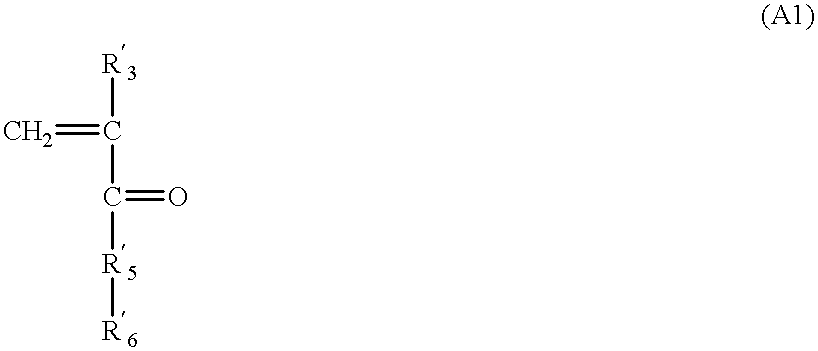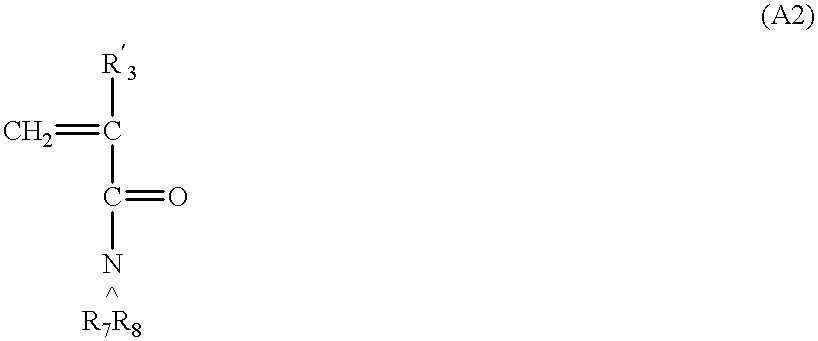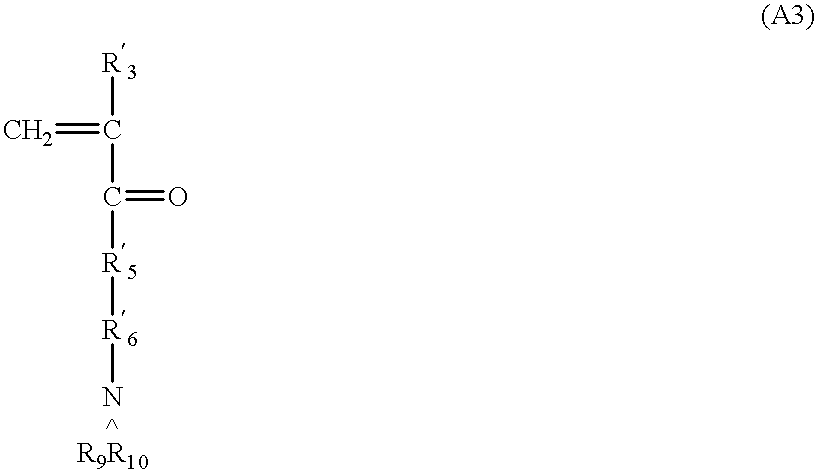Ink-jet printing ink compositions having magnetic properties and specific core/shell binder
a technology of magnetic properties and ink-jet printing, which is applied in the direction of printing, inks, nickel oxides/hydroxides, etc., can solve the problems of compromising competing interests, foregoing cited patents do not provide useful, durable film-forming properties, and ink-jet printers have not had printing performance and durable print properties, etc., to achieve a high degree of permanence
- Summary
- Abstract
- Description
- Claims
- Application Information
AI Technical Summary
Benefits of technology
Problems solved by technology
Method used
Image
Examples
example 1
(Hexyl Acrylate).sub.10 (Methyl Methacrylate).sub.30 (Vinylpyrrolidone).sub.59 (D1).sub.1
Synthesis of core-shell polymer with hexyl acrylate (A), methyl methacrylate (MMA) (B), vinylpyrrolidone (C), and UV stabilizer (D1) (D) in the ratio of 10, 30, 59, and 1% by weight, respectively:
Hexyl acrylate (8 g), MMA (24 g), vinylpyrrolidone (47.2 g) and UV stabilizer D1(0.8 g) were mixed with BRIJ 92 (0.8 g), SOLSPERSE 27,000 (0.82 g), and isooctylmercaptopropionate (0.8 g) in water (12 g) to form an emulsion. The emulsion was saturated with nitrogen. Then the emulsion was added over a period of 1 hour to a solution of potassium persulfate (1.71 g) in water (703.09 g) at 80.degree. C. The reaction mixture was maintained at 80.degree. C. for 2.5 hour. The reaction mixture was then cooled to obtain the title polymer dispersed in water. The average particle size of the polymer solution was found to be 250 nm and the glass transition temperature (T.sub.g) of the polymer obtained was 65.degree....
example 2
(Hexyl Acrylate).sub.30 (Methyl Methacrylate).sub.40 (Acrylamide).sub.30
Synthesis of core-shell polymer derived from hexyl acrylate (A), MMA (B), and acrylamide (E) in the ratio of 30, 40, and 30% by weight, respectively:
The monomers, hexyl acrylate (3 g), MMA (4 g), and acrylamide (3 g) were mixed in water (7 g) containing BRIJ 92 (0.22 g), Aerosol DPOS 45 (0.22 g), and isooctylmercaptopropionate (0.22 g) to form an emulsion. The emulsion was saturated with nitrogen and added dropwise to a solution of potassium persulfate (0.2 g) in water (82.14 g) at 100.degree. C. Heating was continued for a period of 4 hours and cooled to obtain the title core-shell polymer. The average particle size of the polymer solution was found to be 200 nm and the glass transition temperature (T.sub.g) of the polymer obtained was -10.degree. and +125.degree. C.
examples 4-6
In the above Examples 1 to 3, the water-soluble components, such as vinylpyrrolidone (C), were replaced by poly(ethylene glycol) methyl ether acrylate (C) of molecular weight 404 (PEG-Ac(404)) in the corresponding amount to obtain core-shell polymer containing PEG-Ac(404). The resulting polymers and their average particle sizes and glass transition temperatures are given in Table II below.
PUM
| Property | Measurement | Unit |
|---|---|---|
| Tg | aaaaa | aaaaa |
| Tg | aaaaa | aaaaa |
| wt % | aaaaa | aaaaa |
Abstract
Description
Claims
Application Information
 Login to View More
Login to View More - R&D
- Intellectual Property
- Life Sciences
- Materials
- Tech Scout
- Unparalleled Data Quality
- Higher Quality Content
- 60% Fewer Hallucinations
Browse by: Latest US Patents, China's latest patents, Technical Efficacy Thesaurus, Application Domain, Technology Topic, Popular Technical Reports.
© 2025 PatSnap. All rights reserved.Legal|Privacy policy|Modern Slavery Act Transparency Statement|Sitemap|About US| Contact US: help@patsnap.com



